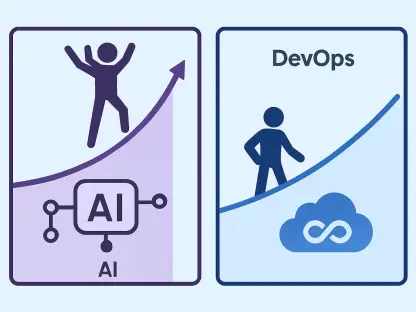The global landscape of API management software is undergoing remarkable changes as demand for efficient digital transformation tools grows. By 2032, the API Management Software Market is anticipated to reach an impressive valuation of USD 12.0 billion. This projection is supported by a Compound Annual Growth Rate (CAGR) of 11.25% from 2025 onwards. The soaring reliance on Application Programming Interfaces (APIs) across a wide array of industries underscores the increasing need for robust API management systems. As more organizations embark on their digital journeys, integrating multifaceted software systems becomes increasingly critical. These management platforms ensure seamless interaction between digital resources, supporting activities such as API design, documentation, analytics, traffic management, and security. The surge in API-driven projects in modern digitized environments brings to the forefront the indispensable role API management plays in advancing business operations and technological interoperability.
Driving Forces Behind Market Expansion
The expansion of the API management software market is driven by multiple factors that together weave a narrative of technological reliance. A key element propelling this growth is the deepening penetration of APIs into various industry verticals, turning them into essential components of digital ecosystems. With the accelerating adoption of cloud computing, IoT, and mobile-first approaches, the demand for secure, reliable, and efficient data exchanges is more prominent than ever. APIs fulfill this demand by facilitating integration, enhancing functionalities, and ensuring scalability within diverse enterprise networks. Notably, the push for digital systems to communicate seamlessly underpins the need for efficient API management solutions. The significance of these software platforms is further compounded by their ability to provide critical business insights through data analytics, thereby enabling informed decision-making processes within organizations.
Another driving factor is the competitive landscape, dominated by influential technology giants. Corporations like Google, IBM, Microsoft, and Amazon Web Services spearhead the competitive arena by offering comprehensive management solutions imbued with innovative capabilities. These platforms boast advancements in cloud-native architectures and incorporate elements like AI-driven automation, real-time monitoring, and complex data management. At the same time, a dynamic influx of smaller, niche players and startups is adding zest to the market. These young companies often champion lightweight, agile API lifecycle solutions tailored for small and medium-sized enterprises (SMEs) and burgeoning digital economies. This blend of established enterprises and disruptors encourages a fertile environment for continuous technological breakthroughs and diverse solution models.
Market Segmentation and Regional Dynamics
API management industry segments can be dissected across components, deployment types, enterprise sizes, and verticals. Solutions within this ecosystem include API gateways, lifecycle management, analytics tools, and developer portals. Simultaneously, essential services such as integration, support, and consulting are gaining prominence as organizations seek comprehensive solutions that address multifaceted business needs. Deployment preferences are notably skewed toward cloud-based solutions, underscoring their scalability and cost-effectiveness, especially pertinent to today’s digitally dependent landscape. The spectrum of enterprises ranges from large-scale organizations to SMEs, with each expressing diverse requirements based on their structural makeup and industry demands.
Analyzing the market from a geographical lens, North America commands the largest share. This dominance is bolstered by a substantial concentration of technology companies alongside a robust IT infrastructure conducive to digital innovations. Not far behind, Europe offers a solid footing thanks to its rich technological heritage and progressive regulatory frameworks that drive the adoption of API systems. However, the Asia Pacific region is projected to exhibit the most aggressive growth rates in the coming years. This surge is mainly fueled by rapid digitalization across nations like China, India, Japan, and South Korea, supported by governmental policies aimed at enhancing their digital infrastructures. The region’s expanding technological base serves as fertile ground for the proliferation of innovative API strategies aimed at propelling economic activities forward.
Underscoring Industry Trends
Emerging trends corroborating the market’s upward trajectory include the proliferation of microservices architecture, regulatory compliance, and security needs. The migration towards microservices—an architecture that enables modular system enhancements—has intensified the demand for robust API management systems. These solutions provide the necessary granularity and monitoring frameworks to manage complex digital environments effectively. Furthermore, increasing regulatory mandates necessitate advanced security measures. APIs must now integrate features ensuring stringent data protection, including access control, encryption, and real-time threat detection, respectively aligning with regulatory compliance requirements globally. Simultaneously, the development of the API economy emphasizes businesses’ strategic maneuvers to monetize their digital assets, adding a new dimension to how APIs are deployed beyond traditional utility paradigms.
In response to such evolving trends, businesses are adopting comprehensive API strategies that align with overarching digital business ambitions. By embedding APIs deeply within their technological frameworks, organizations are not only modernizing their interactions but also driving innovation toward enhanced customer experiences and operational efficiencies. With APIs acting as connective tissue, enterprises now have the opportunity to unlock substantial value from internally developed programs and established third-party networks alike. This paradigm shift paves the way for collaborative ecosystems where data and services flow freely, fostering environments ripe for technological advancement.
Projected Pathways and New Horizons
The API management software sector is experiencing significant evolution, driven by the rising demand for efficient tools to facilitate digital transformation. By the year 2032, forecasts indicate that the API Management Software Market will achieve a substantial valuation of USD 12.0 billion. This expectation is underpinned by a Compound Annual Growth Rate (CAGR) of 11.25% starting from 2025. APIs, critical in numerous industries, highlight the necessity for effective API management systems—essential for organizations as they navigate digital transformations and integrate complex software ecosystems. These platforms ensure effortless integration among digital assets, handling tasks like API design, documentation, analytics, traffic management, and security. With a notable uptick in API-centric projects in today’s digitalized landscape, API management has become crucial for enhancing business functions and ensuring technological compatibility across various systems.









